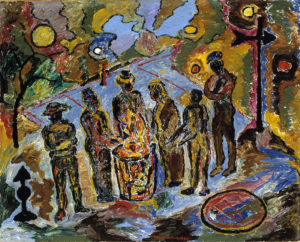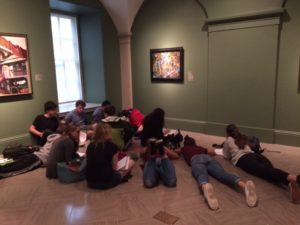
Poetry of Jacques Prévert
Anne Leflot
Washington International School
Advanced French (Literature)
Grade 9
Unit on Jacques Prévert’s Poetry
Overview
This unit focuses on Jacques Prévert’s Paroles, a diverse collection of French poems written in 1946 that mainly deals with the topics of poverty, social injustice, war and love. The students first focused on identifying and understanding Prévert’s style and his dedication to denouncing the social injustice that led to homelessness. Then, they adopted a more global approach, using art to discover how other artists deal with topics of social injustice and homelessness in order to capture how art can be used as a powerful way to raise awareness. They also studied the musical versions of Prévert’s poems to analyze how these adaptations can be a powerful way to reach a wider public. This led students to create their own poem, supported by a visual.
Learning Goals
How can Prévert’s poems can change people’s perspective on the topic of social injustice? Where do we see elements of the Surrealist style in Prévert’s work? What is the global magnitude of the topics in his poems?
UNIT/LESSON PLANS:
Context
Washington International School is a private PreK-12 independent school with a dual language program in French/Spanish and English. The students in this 9th grade class were all native or near-native French speakers. One third of them had documented learning challenges.
This course has two main goals:
- Teach literary analysis, essay techniques and creative writing; and
- Focus on the impact literature has on our understanding of the world, specifically the way it shapes our perception of global issues. (The curriculum is designed in such a way that one global issue per unit is explored, following this order: Women’s Rights in La femme en rouge by the Egyptian-French novelist Andrée Chédid; Racism in Tintin au Congo by the Belgian author Hergé; Social Injustice in Paroles by the French poet Jacques Prévert; and Access to Education in Balzac et la petite tailleuse chinoise by the Chinese author Dai Sijie.)
WIS students in general are part of a privileged community. Most of them are not directly exposed to poverty and homelessness. They understand this phenomenon from an external point of view. By exploring this topic through literature and art, students are able to discover the personal and intimate stories behind it. My hope is that by reflecting on and experiencing ways that art and literature confront societal problems and change people’s perceptions will give them tools and the inclination to better influence the decisions of tomorrow on such topics.
Key Learning Experiences
Step 1: Meet Prévert’s poems
The unit started with a “Chalk Talk” thinking routine on the themes, style, symbols and points of view on society in Paroles. The goal was to build a global idea of Prévert’s style and areas of interest. It was also a way to understand the important place the topic of social injustice takes in this collection of poetry.
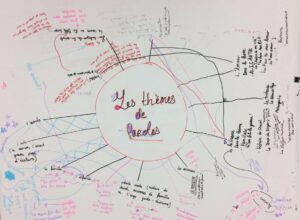
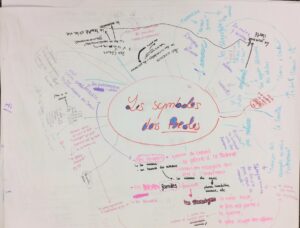
Step 2: Meet a poem on the topic of social injustice
Investigate: We zoomed in on a short and simple poem related to our topic, social injustice, and drew it. The idea was to allow students with learning differences to jump with ease into the exploration of the poem. Drawing allowed them to clearly visualize the poem and pay close attention to the details.

Consider other perspectives: This activity led us to debate our interpretation and understanding of the author’s intention. Students presented their drawings and explained them to the whole class. We compared some of them when we thought there was a conflict or a complementarity between them. It allowed us to deepen our understanding and our analytical skills.
In one example, Faysal realized that, although the character of the poem is frozen, the poem takes place in the summer, hence its title. His confusion led us to a discussion about how Prévert plays with this paradox in order to reveal the situation and denounce it.
Communicate ideas: Finally, students synthesized their understanding of the poem in a short paragraph, using a model for literary analysis.
Step 3: Identify Prevert’s style (Surrealist techniques)
Prévert represents thinking in action in his poem. He jumps from one idea to another, realizing some sort of collage of ideas and thoughts. This technique is representative of the Surrealist movement in which Prévert took part. Surrealist authors were particularly interested in representing dreams and subconscious thoughts. They often used juxtaposition of illogical ideas, obsessive repetitions and striking images that are common in Prévert’s way of writing.
Investigate: In order to deepen our understanding of Prévert’s style, specifically how he uses of Surrealist techniques in his writing, we took a break from our exploration of the topic of social injustice to focus on a poem that represents the thoughts of a man day-dreaming next to a house. Students drew a schematic of the poem–some drew, some wrote notes, there were no specific requirements. The idea was to understand what techniques Prévert uses to give us access to the characters stream of consciousness.


Consider other perspectives / Communicate ideas: In this example, the two drawings revealed a different level of understanding. The first one showed an attempt to capture all the details of the text, while the second one focused more on its main idea. The comparison of these two drawings led us to discover their complementarity. What was missing in their interpretation became obvious for each group. In doing so, students started to realize how the author conveys his message.

In addition, to help students for whom language expression can be quite challenging, we explored a Surrealist work of art. It helped us visualize more concretely how Surrealism represents subconscious thoughts and dreams. We looked at Dream Caused by the Flight of a Bee Around a Pomegranate a Second Before Awakening by Salvador Dali, using the Agency By Design thinking routine “Parts, Purposes, Complexities” to deconstruct the painting and understand its similarities with Into My House. The goal was to have them look at texts (paintings, poems, etc.) in a more critical and analytical way.

Step 4: Understand how Surrealist techniques help Prévert to denounce social injustice
Investigate: For this new step, students used the same thinking routine as for Dali’s painting, “Parts, Purposes, Complexities,” to deconstruct the poem Lazy Morning and connect it with the Surrealist movement. In this poem, Prévert uses Surrealist techniques to give us access to the thoughts of a man who is starving. The use of the same routine helped them identify the similarity of structure between the work of art and the poem.
Consider other perspectives and take action: To help them integrate the concept of Surrealist techniques and Prévert’s interest for social injustice, students were asked to write a poem Prévert might have written about Dream Caused by the Flight of a Bee Around a Pomegranate a Second Before Awakening. The idea was also to realize that people with different interests can interpret the same object or phenomenon with different perspectives. Prévert saw the world through a political lens, while Dali’s area of interest is the exploration of dreams and subconscious thoughts. One can imagine that Prévert would have interpreted Dali’s dream in a different way. Here is an example of Ainhoa’s idea on that matter.
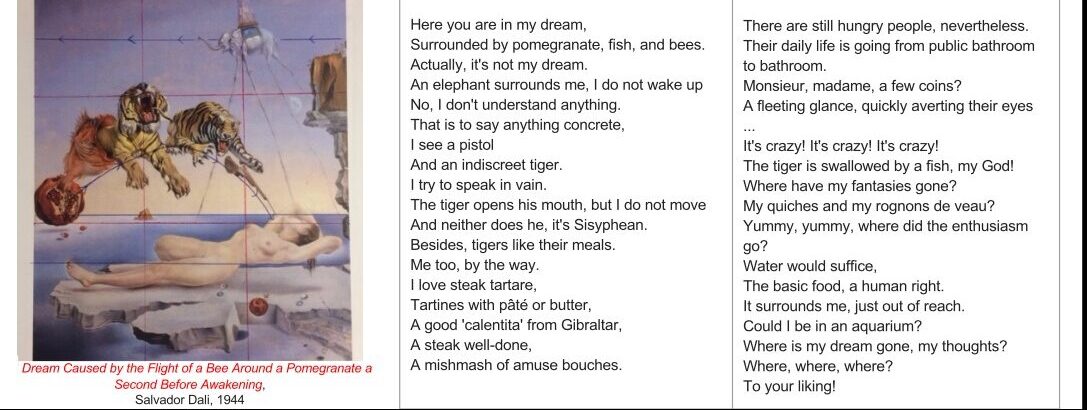
Step 5: Explore works of art related to social injustice
Investigate: After our exploration of Prévert ‘s themes and his Surrealist techniques, we moved to the exploration of other works of art from different backgrounds in order to broaden our understanding of the way artists deal with the topic of social injustice and influence our perception of it. On a field trip to the Smithsonian American Art Museum (SAAM) and National Portrait Gallery (NPG)–which are in the same building–together as a class we first analyzed, as a whole group, Can Fire in the Park by Beauford Delaney, using the thinking routine called “Circle of Viewpoints.”
The format of the questions helped them connect the painting with Prévert’s poetry. For instance, when asked how social relations, cultural values and views of themselves may shape their perspective on the situation, they saw a willingness from the two artists to denounce poverty by provoking empathy through colors and striking images. They mentioned that, like in “Summer,” the artist put in front of us a situation that we would normally try to ignore, as a way to force us to acknowledge it. They also discovered that, while the two artists wanted to describe homelessness, Prévert dealt with the topic with an external and politic eye, whereas Delaunay took a more personal approach, describing a situation of poverty he had experienced before.
Step 6: Find and analyze works of art aimed at denouncing an injustice
Investigate: After we analyzed Can Fire in the Park, the students broke into groups of 2 or 3 and went to find and analyze a work of art that, like some of Prevert’s poems, denounces something and aims at inspiring a change.
Communicate ideas: Students presented their choice work of art, using the global thinking routine “The 3 Y’s.” This led us to interesting conversations about an artist’s intent as opposed to one’s own interpretation. It also allowed us to realize the variety of strategies and topics related to social injustice.
Some students found a work of art closely related to Prévert’s interest in social injustice (Iceman Crucified #4 by Ralph Fasanella). Others made some more distant connections (Westward the Course of the Empire Takes Its Way, mural study, U.S. Capitol by Emanuel Gottlieb Leutze). Several unexpected connections showed a deep understanding of Prévert’s poems (Seal Rocks, San Francisco by Albert Bierstadt).
Step 7: Write a poem that denounces a social injustice
Investigate: For our final activity, we studied the adaptation of “Lazy Morning” by Prévert into a video-clip sung by Marianne Oswald in 1945. Students reflected on the efficiency of this adaptation and its ability to reach a broader public. We also discussed the possibility of doing the same kind of video nowadays. Who would be the new Marianne Oswald? Which format would be the most appropriate or efficient to reach a large audience?
Take action: This discussion led us to our final project: Students created a poem inspired by Prévert, works of art at the SAAM, or both. The goal of the project was to inspire a change. The poem had to be supported by a visual.
In the example below, Juliette was inspired by a reflection she had at her church the day before we started the project. She had served food to homeless people for the first time in her life and came to realize that her assumptions and fears about them were not justified. Their warmth and politeness made her feel guilty about her former feelings. She decided to write a poem in which she intended to change people’s minds by encouraging them to look at homeless people for who they really are. In addition, in order to make her poem more powerful, she drew a beautiful eye that aimed at showing both the depth and the humanity of homeless people.
| Un Échange de Regard Elle arrive bouclée, maquillée, richement habillée, Sa démarche gracieuse et assurée, Les yeux rayonnants.Il est assis dans la rue, le visage sale et mal rasé, Vautré dans ses habits trop grands, Les épaules voûtés, le yeux creusés. Elle et lui, Nous et eux.Deux scénarios se présentent:Elle s’approche, évite son regard, Fouille dans son sac, sort une pièce de monnaie, la jette dans le gobelet, Et continue sa route.Il la voit s’approcher, Redresse sa tête et cherche son regard, Entend tomber la pièce, Et la regarde s’enfuir.Ou bien… |
Elle s’approche, s’arrête et le regarde droit dans les yeux, Lui sourit, lui parle, lui met un billet dans la main, Lui souhaite une bonne journée en le quittant.Il la voit s’approcher, Redresse sa tête et rencontre son regard, Lui rend son sourire, Reçoit le billet dans la main et reprend courage.Elle et lui, Nous et eux. Dans la même ville, Un monde qui nous sépare… Que faire, contre cette injustice éternelle?Partager un regard Apporter un sourire Leur tendre la main Et surtout… Reconnaître qu’ils existent à nos yeux. |
Translation:
| An Exchange of Glances
She arrives with curly hair, all made up, richly dressed, Two possible scenarios: She approaches, avoids his gaze, He sees her approaching, Or… |
She approaches, stops and looks him straight in the eye, Smiles at him, talks to him, puts a note in his hand, Wishes him a good day before leaving.He sees her approaching, Looks up and meets her gaze, Smiles at her, Takes the note in his hands and regains courage.She and he, We and they. In the same town, A world that separates us … What is to be done against this eternal injustice?Share a look Bring a smile Give them a hand And especially… Recognize that they exist in our eyes. |
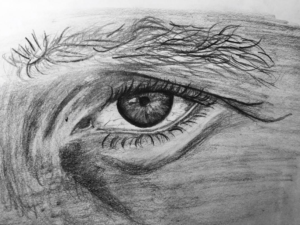 Teacher Reflections
Teacher Reflections
Developing global competence: Students came to discover the role art and literature can play in raising awareness about global issues such as poverty, homelessness and social injustice. They were also able to reflect on ways to use art and literature as a tool to sensitize the public to sensitive issues. By creating their own poem and visual, they discovered what is behind the process of inspiration and realized the frustration and joy that can come out of the urge to be understood and to persuade.
The added value of the inclusion of art and the museum visit: By comparing works of art with poems, students also realized that denouncing poverty is a common interest shared by artists from different backgrounds, times and countries. It helped them reflect on the global magnitude of the problem and the variety of reasons behind social injustice.
While the analysis we did as a group dealt with denouncing the situation of homeless people, the visit to the museum helped us broaden our understanding of the topic of social injustice and ways to denounce it. From homelessness in Paris in 1945, we traveled to New York to discover the same situation among African American people. Then, on their own, students realized that this situation had common points with people who can no longer afford to live in their newly gentrified neighborhood in L.A. (10828 Avalon Blvd. LA, by Camilo José Vergara), who suffer their all lives to support their family in New York (Iceman Crucified #4), or whose land is colonized by others in the name of God and Manifest Destiny in the 19th century (Westward the Course of Empire Takes Its Way).
Although the exploration of art did not always take the direction I expected, I feel that the activities really helped the students take ownership of their learning because it gave them the opportunity to bring their reflection to a more personal level. Faysal, who is from Lebanon, saw injustice in 10828 Avalon Blvd. LA, because it made him think of the destruction of Lebanon’s historic buildings and the culture and soul they represent. Julia, who defines herself as a Christian, was very moved by Iceman Crucified. Madeline and Juliette, who loves seals, selected Seal Rocks because they thought that Prévert, who often conveys his point of view by using animals in his poem, would have found this painting particularly relevant for symbolically representing social injustice.
These activities were a good indicator that images help support students’ understanding of texts. It also revealed that studying works of art can bring the exploration of a topic to new heights and that, with guided freedom, students can find personal connections that allow them to take ownership of their learning and deepen their analysis, even if it is not in the way the teacher expected.
Challenges: Before I started this unit on Prévert and art, my concern was to make the third of my students who has documented learning differences feel at ease with the complexity of Prévert’s writing. I expected the study of his poems to be challenging, especially since French is not, for most of them, their native language.
I also was not sure about how some of my students would react to the comparison between art and literature. I wondered if the variety of texts would complicate their understanding. Having my students draw poems and put words to works of art definitely helped them. It gave them a chance to visualize poems and see the similarities between literature and art.
A challenge I did not anticipate was the choice of works of art some of my students made when they had to select one on their own at the museum. I realized that their selection was very oriented and influenced by our analysis of Prévert’s poems. Some students clearly saw Prévert everywhere, no matter the artist’s intent.
The difficulty was also taking into account that students make their own connections according to their level of understanding and independence of thought. Since art is by nature open to interpretation, their prior knowledge and perception of the world could lead to opposite interpretations.
I feel that the exploration of works of art is more powerful when they are not obviously connected to what we are studying. I think that the analysis is more fruitful when there is room for wonder and mystery.
Researcher Reflections
Anne methodically uses thinking routines in her classes, so that by the time this unit took place in the year the grade 9 students were familiar with them and knew that the expectation in the course was to think deeply. Admirably, Anne found varied ways to engage learners, to differentiate. She planned the unit knowing that many of her students struggled with language but also understanding that they had quite complex ideas about the world around them. Her use of visuals throughout the unit gave students ready access to the language of the poetry.
Using elements of the Global Competence framework (Boix-Mansilla & Jackson, 2011) in planning the various learning activities along the way afforded Anne the opportunity to ensure that the students were broadening their understanding of the poems under study to larger concerns in the world.
Anne’s reflections are especially important to consider. She shows flexibility in letting the students have an abundance of choice throughout the unit and in allowing their interpretations and interests take the exploration in unexpected directions. The students surely benefited from examining art and literature from the various lenses they tried on–significantly, neither merely served the other. They stood on equal footing in the way Anne valued them in her selections and in the assignments she gave.

